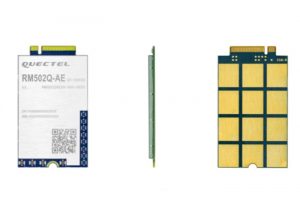At CES 2021, the Chinese wireless telecommunication equipment manufacturer Quectel Wireless Solutions launched three 5G New Radio (NR) Sub-6 GHz modules, including models RM500Q-AE, RM502Q-AE and RM505Q-AE, with the aim of foster the massive deployment of 5G smart connections around the world.
Leveraging Qualcomm’s Snapdragon X55 commercial 5G modem, all three Quectel 5G NR modules feature ultra-fast technology, low latency, and an enhanced Carrier Aggregation (CA) system, and are now ready to be sampled for supporting a wide range of enhanced mobile broadband networks and IoT applications such as Fixed Wireless Access (FWA), 4K/8K live streaming, online meeting applications, telemedicine, transportation intelligent and industrial IoT.
With their stand-alone and non-stand-alone modes, the three 5G wireless modules enable global coverage of the 5G NR Sub-6 GHz, LTE-A and WCDMA frequency bands and provide reliable 5G solutions to international IoT customers.
Other key features of the modules:
- Global coverage of 5G frequency bands
- Multigigabit data rate up to 5.0 Gbps
- DL 4X4 MIMO for 5G NR and LTE-A bands
- Multi-resource GNSS capabilities
- Abundant interfaces: USB 3.0 / 3.1, PCIe 3.0 and eSIM
- Dimension M.2, compatible with Quectel LTE-A Cat 6 / Cat 12 / Cat 16 modules
- All three modules also integrate GNSS capabilities, with the RM505Q-AE supporting active GPS L1/L5 signals for more accurate positioning services. This allows industrial terminals like rugged tablets and on-board computers to operate in weak signal environments, such as valleys, forests and urban canyons.
At present, the Quectel RM502Q-AE module has obtained IC / FCC / PTCRB / GCF / RED / RCM certifications, while the Quectel RM500Q-AE and Quectel RM505Q-AE modules have obtained CE / RCM certifications. These mandatory approvals with Global Launch Base (FW) firmware help customers quickly enter each local market and reduce their device development and certification costs.
